Police and the public hold sharply different views about key aspects of policing as well as on some major policy issues facing the country. For example, most police say more officers are needed to adequately patrol their communities, while the majority of the public doesn’t think more officers are necessary. A majority of officers oppose a ban on assault-style weapons, while a majority of the public favors a ban on these weapons. More than eight-in-ten police say people don’t understand the risks and rewards of police work well, while an equally large majority of the public says they do.
At the same time, there are areas of broad agreement between officers and the public. Majorities of the police and public favor the use of body cameras by officers to record interactions with the public. Large majorities of police and the public also support easing some legal restrictions on marijuana, though the public is more likely than officers to support the legalization of marijuana for both personal and medical use (49% vs. 32%).
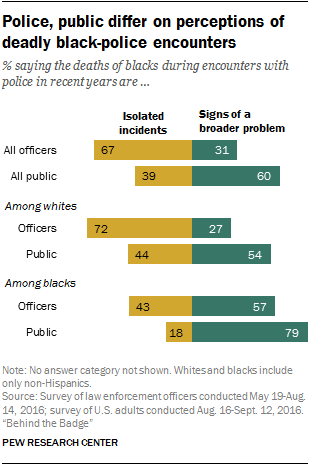
These contrasting views and striking similarities emerge from two surveys, one of 7,917 sworn police officers conducted online May 19-Aug. 14, 2016, and the other a nationally representative survey of 4,538 adults conducted Aug. 16-Sept. 12, 2016, by mail and online. The surveys included a number of identically worded questions, which allowed for direct comparisons of how officers and the public see the role of the police in their communities and how they view recent deaths of blacks during encounters with police, as well as to capture their views on some major policy issues, including gun control, the use of body cameras by officers and assessments of racial progress.
Some of the sharpest differences between the police and the public emerge over views on deaths of blacks during encounters with police in recent years and the protests that many of those incidents ignited. For example, 67% of the police but only 39% of the public describe these deadly encounters as isolated incidents rather than signs of a broader problem between blacks and police. When this overall finding is analyzed by race, an equally striking result snaps into focus: About seven-in-ten white officers (72%) but fewer than half of all black officers see these encounters as isolated incidents. By contrast, majorities of black officers (57%) as well as the public overall (60%) say the incidents are signs of a broader problem between police and the black community.
When the subject shifts to overall views on racial progress, large differences again emerge between the public and the police and also between blacks and whites within each group. For example, when police and the public are asked if the country has made the changes needed to give blacks equal rights with whites, fully eight-in-ten police officers – including 92% of white officers but only 29% of black officers – say the necessary changes have been made. By contrast, about half (48%) of the public, including 57% of whites but only 12% of blacks, says the country has made the changes needed for blacks to have equal rights with whites.
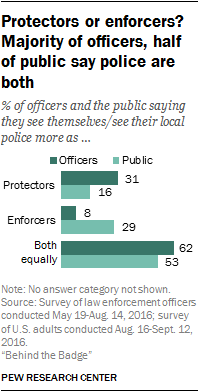
The remainder of this chapter examines these and other related findings in greater detail. The first sections compare and contrast police and public views on the role of police in the community and how each group views the risks and rewards of police work. The next sections describe how each group views recent deadly encounters between police and blacks and also examines police and public attitudes toward the protests that followed many of these incidents. The final section examines police and public attitudes on some current issues relevant to law enforcement, including gun policy, legalization of marijuana and racial equality.
How the public sees the police, how police see themselves
Protectors, enforcers or both – what do Americans see when they look at their local police? And do their perceptions of the police align with what officers say is their primary role?
Overall, about six-in-ten (62%) officers say their primary role is to serve as both protectors and enforcers; among the public, about half (53%) view their local police this way.
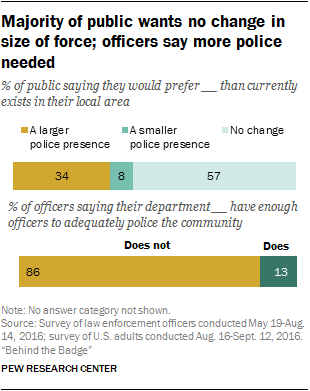
At the same time, three-in-ten officers (31%) say their primary role is to serve as protectors, about twice the share of the public (16%) who see their local police in that way.
An even larger disparity between police-public views emerges over the enforcement role of police. Only 8% of officers say they mainly see themselves as enforcers – the long arm of the law – yet fully three times the share of the public (29%) see their local police that way.
This disparity over how the public views police and how officers see their role is partially explained by race. Blacks are significantly more likely than whites to see their local police as mainly enforcers (39% vs. 26%) and less likely to see officers as both protectors and enforcers (43% vs. 57%).
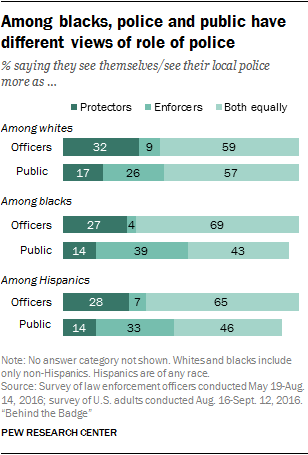
Overall, 46% of Hispanic adults see police in their community as both enforcers and protectors, while 33% view them as enforcers and 14% as protectors. Among Hispanic officers, about two-thirds (65%) see their role to be both protectors and enforcers, while 7% say they are enforcers and 28% consider themselves to be protectors.
Contrasting views on size of police force
When it comes to manpower, police are unequivocal: More than eight-in-ten officers (86%) say their department does not have enough police to adequately patrol their community. By contrast, a majority of the public (57%) wants no change in the size of the local police force. About a third of the public (34%) want more officers in their local area, and 8% favor fewer officers.
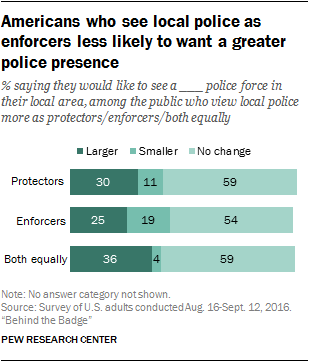
Among the public, these differences are linked, in part, to how they see their local police. Among those who view the local police as mainly being enforcers, a quarter say they want more officers and 19% would favor a smaller police department. The remaining 54% favor no change.
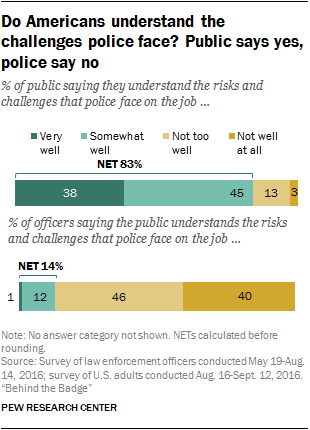
At the same time, roughly a third (36%) of those who see the police as both protectors and enforcers would prefer to see more officers. Only 4% favor a smaller force, while 59% prefer the current level of policing. Similarly, about a third of those who view their police as protectors (30%) favor a larger police presence, 11% would like a smaller force and 59% prefer no change. (The views of police on whether there are enough officers in their communities are far more unequivocal: About eight-in-ten or more in each group says their department falls short of having the number of officers their community needs.)
Police work: Great risks, great frustrations
The overwhelming majority of Americans say they understand the risks and challenges that police face. And an equally lopsided share of police disagrees.
Fully eight-in-ten Americans (83%) say they understand the risks and challenges of police work – including 38% who believe they understand the risks very well. By contrast, fully 86% of the police say the public does not fully comprehend the trials that officers face – including 40% who say Americans don’t understand well at all the risks and challenges of police work.
Another survey finding provides a striking example of an apparent disconnect between what the public thinks police work is like and the reality of law enforcement.
Perhaps influenced by popular television police dramas that routinely feature vividly choreographed shootouts, more than eight-in-ten Americans (83%) believe that typical police officers fire their service weapon while on duty at least once in their career – and about three-in-ten (31%) believe police discharge their weapon at least a few times a year.
In fact, only about a quarter of all officers (27%) say they have ever fired their service weapon.14
Police work more dangerous, more frustrating
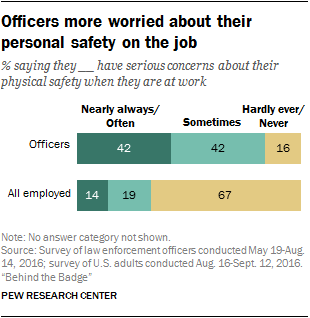
But how do police view the risks and rewards of their work, and how do those views differ from Americans in other occupations? To partially answer those questions, the surveys asked officers and employed Americans how often they worried about their physical safety while at work, how often their job made them feel frustrated and how often it made them feel fulfilled.
Average police officers are three times as likely as workers overall to say they nearly always or often have serious concerns about their physical safety while on the job (42% vs. 14%). Employed Americans, meanwhile, are about four times as likely as officers on average to say they hardly ever or never seriously worry about their physical well-being at work (67% vs. 16%).
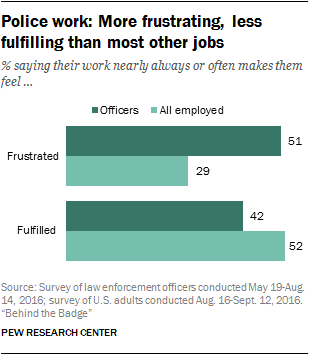
Officers also are more likely on average than employed Americans overall to say their jobs frequently make them feel frustrated and somewhat less likely to feel fulfilled by their work. Half (51%) of officers say their job nearly always or often frustrates them, compared with 29% of all workers. A larger share of white officers report feeling frustrated by their job than do white workers overall (54% vs. 28%).
At the same time, about four-in-ten officers (42%) say their work frequently makes them feel fulfilled, compared with half of employed adults (52%) who feel that way. There was no significant difference between white and black officers.
Officers, public agree that police work is more difficult now
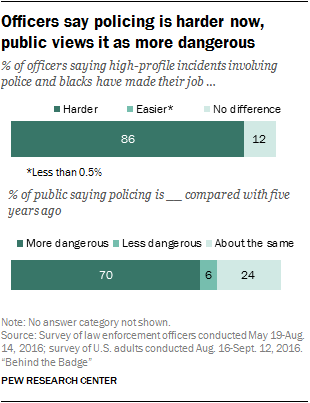
The public and officers agree that recent deaths of blacks during incidents with police and the protests they have sparked have added to the challenges of police work. More than eight-in-ten officers (86%) say their job is harder now as a result of the protests. At the same time, seven-in-ten Americans believe police work has become more dangerous in the past five years.
On both measures, solid majorities of whites and blacks agree police work is harder now, though whites are more likely than blacks to say policing has become more challenging. About nine-in-ten white officers (89%) and 81% of black police say their job has gotten harder. Similarly, roughly three-quarters of whites (74%) in the general population and 60% of blacks say policing has become more hazardous in recent years.
Public, police see deadly police-black encounters differently
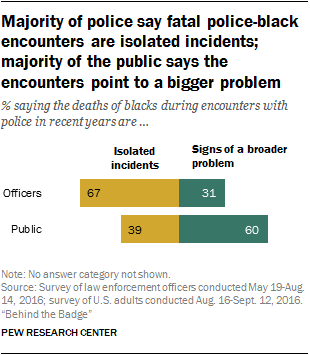
Police and the public describe the recent fatal incidents involving blacks and the police in very different ways.
Roughly two-thirds of the police (67%) say these deadly encounters are isolated incidents, while about three-in-ten (31%) say they are signs of serious problems between law enforcement and the black community. But when the public is asked to consider these incidents, the result is virtually reversed: Six-in-ten say these encounters are signs of a broader problem, while 39% describe them as isolated incidents.
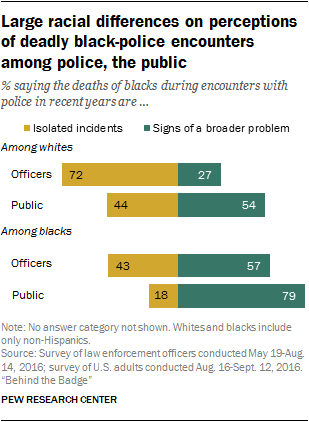
These differences grow sharper when race is added to the analysis. Black and white officers see these incidents very differently, as do whites and blacks in the general public.
For example, about seven-in-ten white police officers (72%) and 44% of whites overall say fatal black-police encounters are isolated incidents. By contrast, only about four-in-ten black officers (43%) and 18% of blacks overall share this view.
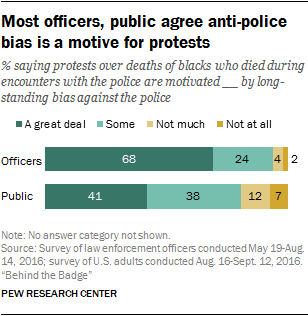
At the same time, black officers are about twice as likely as blacks nationally to describe these encounters as isolated incidents (43% vs. 18%). And while a narrow majority of black officers (57%) say the incidents are signs of a broader problem, a much larger majority of blacks overall (79%) express this view. In fact, roughly similar shares of black police and whites overall – 57% and 54%, respectively – see these incidents as pointing to larger issues between blacks and law enforcement.
Anti-police bias is seen as a motive for protests by most officers and public
Large majorities of the police and the public agree that long-standing anti-police bias was at least some of the principle behind the protests that have followed many of the recent fatal incidents involving blacks and the police.
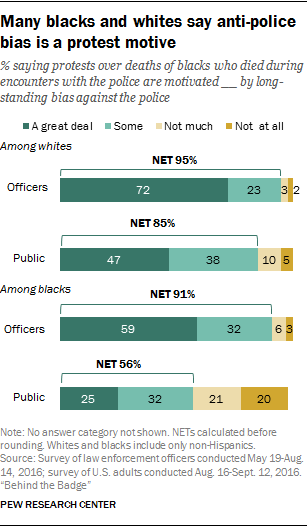
About nine-in-ten officers (92%) say the protests were motivated by bias toward the police, including 68% who say this was a great deal of the reason behind the demonstrations. A smaller but still substantial 79% majority of the public agrees that prejudice against the police provided at least some of the impetus for the protests, including 41% who see this as a major motivation.
A familiar pattern emerges when race is factored into the analysis. Black and white officers differ somewhat about the motives of the protesters, and the views of each group differ with those of all blacks and whites.
Fully nine-in-ten white officers (95%) and 85% of whites nationally say the protests are motivated at least somewhat by anti-police bias. Underlying this modest difference is the much larger share of white officers who feel that long-standing animosity toward police is a great deal of the protesters’ motivation (72% of white officers vs. 47% for all whites).
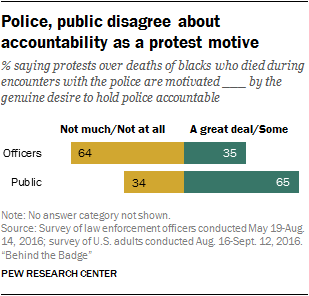
Among blacks, the disparity between police and the public is even greater than it is among whites. About nine-in-ten black officers (91%) say anti-police feelings are a reason for the protests. By contrast, 56% of blacks overall share this view.
Again, the belief that anti-police bias is a major reason behind the demonstrations is more strongly held by black officers. Black officers are more than twice as likely as blacks generally to say bias was a great deal of the reason for the demonstrations (59% of black officers vs. 25% of all blacks).
White officers more skeptical that accountability motivated protests
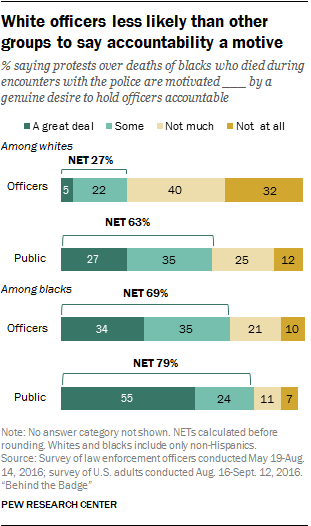
The police and the public also disagree about how important a motivation the desire to hold police accountable was to protesters. The difference is dramatic: Only about a third of all officers (35%) say the desire to make officers answerable was at least some of the motivation for the demonstrations, while 65% of the public says accountability was a factor.
A different pattern emerges when blacks and whites are asked the degree to which they believe the protests are genuine attempts to force police accountability. White officers stand apart; they are far less likely than whites generally, black officers or blacks to see holding officers answerable for their actions as a major goal of the protests.
About a quarter (27%) of white officers say accountability motivated the protests; by contrast, more than twice the share of whites overall (63%) say this. In fact, a quarter of whites overall (27%) say the desire for police accountability was a great deal of the reason for the protests – identical to the share of police who say accountability was either a great deal (5%) or some (22%) of the motivation, combined.
Blacks, both officers and in the public, see the desire for accountability as a driving factor behind the protests. About seven-in-ten black police officers (69%) say concerns about police accountability played at least some role in the protests, a view shared by 79% of all blacks. Moreover, blacks nationally are significantly more likely than black officers to say this was a great deal of the motivation for demonstrators (55% vs. 34%).
Broad support for body cameras
One consequence of recent fatal encounters between police and blacks has been the growing call for police to wear video cameras to record interactions between officers and the public. While some law enforcement organizations, including the police unions in Miami and Boston, have attempted to slow down efforts to make officers wear “body cams,” the surveys find that a clear majority of officers and a larger share of the public support their use.
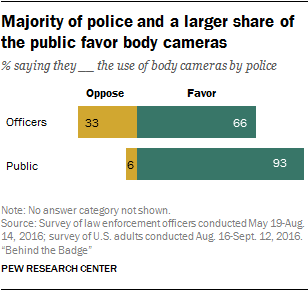
Two-thirds of the police (66%) and an even larger share of the public (93%) favor the use of body cameras by police to record interactions between officers and the public. However, the surveys also find that police see relatively fewer benefits than the public does from the use of body cams by officers.
About six-in-ten Americans (59%) but only a third of police say body cams would make members of the public more likely to cooperate with officers. By contrast, a majority of police (56%) says body cams would make no difference, a view shared by about a third (35%) of the public. Only 5% of the public and 10% of the police say members of the public would be less likely to obey officers who are wearing body cameras.
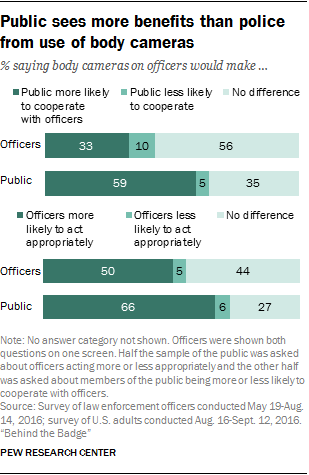
Police are somewhat more convinced about the positive effects of body cameras on police behavior than on the public’s behavior. Half of officers and two-thirds of the public (66%) say a police officer would be more likely to act appropriately when wearing a body cam. At the same time, 44% of officers and 27% of the public doubt that wearing body cams would have an impact on police behavior, while small shares of officers and the public say officers would be less likely to act appropriately (5% and 6%, respectively).
Broad support from police, public for some gun law reforms
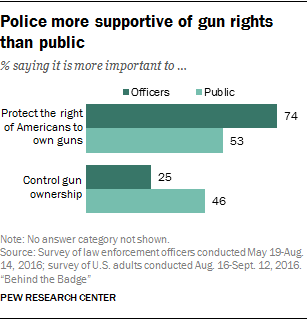
Police officers are considerably more likely than the general public to say it is more important to protect the rights of Americans to own guns than it is to control gun ownership (74% of officers vs. 53% of the public). At the same time, there is widespread agreement between police and the public on several key gun law reforms. For example, more than nine-in-ten officers and almost the same share of the public favor laws that would prevent the mentally ill from purchasing guns (95% and 87%, respectively). And about the same proportions of the police and the public favor background checks for people who buy weapons at a gun show or from a private individual (88% and 86%, respectively).
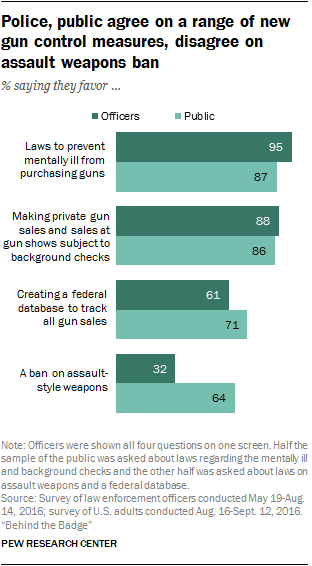
A majority of police and a larger share of the public also support the creation of a federal database to track gun sales (61% and 71%, respectively).
However, the consensus on guns vanishes when the focus turns to assault-style weapons. About two-thirds of Americans (64%) but only about a third of police (32%) favor outlawing assault weapons.
The gender gap among police on this issue is among the largest of any question in this survey: A majority of female officers (57%) favor a ban on assault weapons, compared with about a quarter of their male colleagues (27%). This disparity mirrors the overall gender gap in the country as a whole: 74% of women and 54% of men favor making these weapons illegal.
A majority of police, public support easing some restrictions on marijuana
As more jurisdictions move to decriminalize or legalize the private use of marijuana by adults, large majorities of the police and the public favor easing restrictions on the drug. However, a larger share of the public than police favor legalization of marijuana for personal and medical use (49% vs. 32%).
Overall, about seven-in-ten officers support allowing medical use of marijuana (37%) or favor the legalization of the drug for both personal and medical use (32%). The public is more favorably inclined than police toward relaxing marijuana laws; more than eight-in-ten Americans support either legalizing marijuana (49%) or allowing only medical use of the drug (35%).
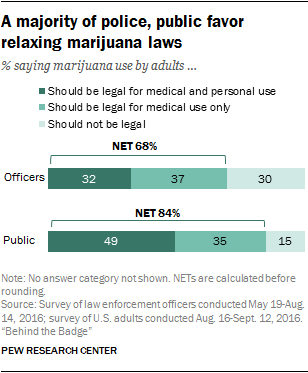
The surveys found little support among the public for outlawing marijuana use under any circumstances (15%). However, police are twice as likely as all adults to favor an outright ban on the drug (30%).
As with younger adults generally, officers younger than 35 are more likely than those ages 50 to 60 to favor permitting personal and medical use of marijuana (37% vs. 27%). Among the public, a majority of adults (63%) under the age of 45 favor legalization.
Police say no more changes needed to achieve racial equality; public divided
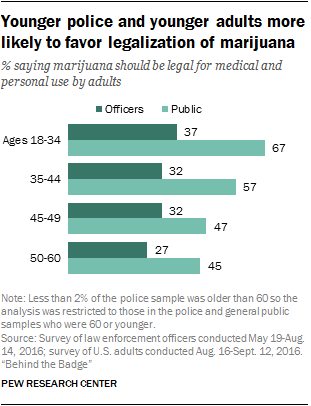
The wide disparities in the views of blacks and whites in American society over whether more changes are needed to achieve racial equality loom even larger in the country’s police departments.
Overall, the surveys find that police are significantly more likely than the public to say the country has made the changes necessary to give blacks equal rights with whites (80% vs. 48%). By contrast, half of the public believes the country still needs to make changes to achieve racial equality, a view shared by only 16% of police.
Underlying these overall results are sharp disagreements between blacks and whites on this issue – a racial divide that is wider within America’s police departments than it is in the country as a whole.
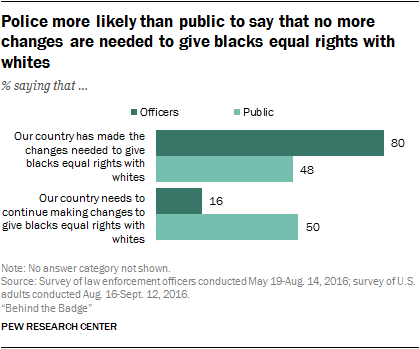
Fully nine-in-ten white police officers (92%) say the country has made the needed changes to achieve racial equality. Nationally, a modest 57% majority of whites say this, a difference of 35 percentage points.
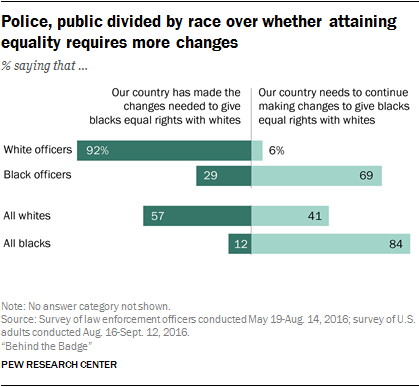
The differences between black officers and blacks overall is significantly smaller. About three-in-ten black officers (29%) say the necessary changes have been made, a view shared by only 12% of blacks nationally and a 17 percentage point difference. By contrast, large majorities of black officers and blacks overall believe more changes are needed (69% and 84%, respectively).




